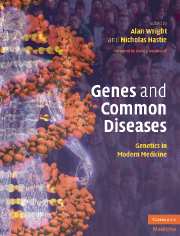Book contents
- Frontmatter
- Contents
- List of Contributors
- Foreword
- Section 1 Introductory Principles
- Section 2 Common Medical Disorders
- 13 Developmental disorders
- 14 Genes, environment and cancer
- 15 The polygenic basis of breast cancer
- 16 TP53: A master gene in normal and tumor suppression
- 17 Genetics of colorectal cancer
- 18 Genetics of autoimmune disease
- 19 Susceptibility to infectious diseases
- 20 Inflammatory bowel diseases
- 21 Genetic anemias
- 22 Genetics of chronic disease: obesity
- 23 Type 2 diabetes mellitus
- 24 Genetics of coronary heart disease
- 25 Genetics of hypertension
- 26 Obstructive pulmonary disease
- 27 Skeletal disorders
- 28 The genetics of common skin diseases
- 29 Molecular genetics of Alzheimer's disease and other adult-onset dementias
- 30 Major psychiatric disorders in adult life
- 31 Speech and language disorders
- 32 Common forms of visual handicap
- 33 Genetic and environmental influences on hearing impairment
- 34 Pharmacogenomics: clinical applications
- Index
- References
26 - Obstructive pulmonary disease
Published online by Cambridge University Press: 17 August 2009
- Frontmatter
- Contents
- List of Contributors
- Foreword
- Section 1 Introductory Principles
- Section 2 Common Medical Disorders
- 13 Developmental disorders
- 14 Genes, environment and cancer
- 15 The polygenic basis of breast cancer
- 16 TP53: A master gene in normal and tumor suppression
- 17 Genetics of colorectal cancer
- 18 Genetics of autoimmune disease
- 19 Susceptibility to infectious diseases
- 20 Inflammatory bowel diseases
- 21 Genetic anemias
- 22 Genetics of chronic disease: obesity
- 23 Type 2 diabetes mellitus
- 24 Genetics of coronary heart disease
- 25 Genetics of hypertension
- 26 Obstructive pulmonary disease
- 27 Skeletal disorders
- 28 The genetics of common skin diseases
- 29 Molecular genetics of Alzheimer's disease and other adult-onset dementias
- 30 Major psychiatric disorders in adult life
- 31 Speech and language disorders
- 32 Common forms of visual handicap
- 33 Genetic and environmental influences on hearing impairment
- 34 Pharmacogenomics: clinical applications
- Index
- References
Summary
Introduction
Obstructive pulmonary disease describes a heterogeneous group of diseases which are characterized by airflow obstruction on expiration. This is defined as a forced expiratory volume in one second (FEV1) of less than 80% predicted with a ratio of forced expiratory volume in one second to forced vital capacity (FEV1/FVC) of less than 70%. Asthma and chronic obstructive pulmonary disease (COPD) account for the vast majority of the global disease burden from obstructive pulmonary disease and these two conditions will be the focus of this chapter.
Asthma
Asthma is an inflammatory condition of the airways which results in bronchial reactivity to a variety of stimuli with consequent narrowing of the airways. This results in airflow obstruction which is usually reversible (National Heart, Lung, and Blood Institute, 1992; Department of Health and Social Services, 2003). The cardinal features of airway inflammation, bronchial hyper-reactivity and reversible airflow obstruction give rise to the symptoms of wheeze, breathlessness, cough and chest tightness which are usually the basis for the diagnosis of asthma. Although these symptoms are not specific, the hallmark for the diagnosis of asthma is their intermittent nature, reversibility, diurnal variation and the recognition of specific triggers (British Thoracic Society; Scottish Intercollegiate Guidelines Network, 2003). Asthma is strongly associated with atopy as demonstrated by the link with eczema and hay fever and the detection of IgE, or a positive skin prick test, to a specific allergen (Witt et al., 1986; Woolcock et al., 1987).
- Type
- Chapter
- Information
- Genes and Common DiseasesGenetics in Modern Medicine, pp. 391 - 405Publisher: Cambridge University PressPrint publication year: 2007



